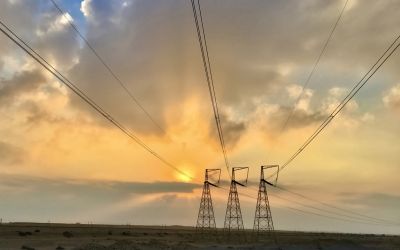Let’s Talk About Risk
Climate change presents an increasingly growing risk to the global economy, threatening long-term prosperity and the exposure of the financial system. In recent years, nature has inched from the periphery of discussions on risk, with growing recognition on nature-related dependencies. Yet, there is still major steps to be taken to price nature into the financial system.

The rise of climate and nature-related risks
Climate change and biodiversity loss are two intertwined existential threats that require urgent action. Climate and nature-related risks present themselves in a myriad of ways, referring to the potential financial, social, or environmental harms caused by climate change and biodiversity loss. These can be categorised as:
Physical risk - Those associated with the impacts from climate change and biodiversity loss, including increased severity of extreme weather events and longer-term shifts in climate patterns. These are likely to alter the supply and demand dynamic of many industries and lead to physical damages to assets.
Transition risk – Those related to the transition to a lower-carbon economy and a misalignment of economic actors with actions aimed at protecting, restoring, and/or reducing negative impacts on nature. This includes reputational risks.
Liability risk – Those referring to economic and financial actors who have experienced losses from the effects of climate change or climate policies/regulations, and seek compensation from those they hold responsible.
The Intergovernmental Panel on Climate Change (IPCC) states that exposure to risks from climate change is projected to double between the 1.5°C and 2°C global warming levels and double again between a 2°C and 3°C world, across multiple sectors. With current policies set for a temperature increase of 2.6-3.1°C over the course of this century, action to mitigate and adapt to these risks is crucial for the stability of the global economy.
Pricing climate and nature-related risks into the financial system
Ultimately, climate and nature-related risks are financial risks. Central Banks have begun to introduce climate into their stress testing. The Bank of England ran its first exploratory scenario exercise on climate risk in 2021 involving the largest UK banks and insurers, testing the resilience of the UK financial system to the transition and physical risks associated with different climate pathways.
As laid out by The University of Cambridge Institute for Sustainability Leadership’s (CISL) Handbook for Nature-related Financial Risks, nature loss becomes a financial risk when physical, transition and liability risk manifest, causing negative impacts upon:
1. Companies and governments, to which financial institutions are exposed via loans, debt and/or equity holdings and/or revenues from financial services
2. Financial markets, including commodity and money markets, to which financial institutions have exposure through investments or financial services (e.g. derivatives)
3. The operations or property of financial institutions, e.g. a lack of green space in cities can lead to fast water runoff causing flash flooding that damages FI property
The Intergovernmental Science-Policy Platform on Biodiversity and Ecosystem Services (IPBES) Nexus Assessment estimates $58tn of global annual economic activity generated in sectors in 2023 were moderately to highly dependent on nature, equating to more than 50% of global gross domestic product (GDP). However, the report emphasises that current decision-making prioritises short-term financial returns while ignoring costs to nature. It is estimated that the unaccounted-for costs of current approaches to economic activity – reflecting impacts on biodiversity, water, health and climate change, including from food production – are at least $10-25tn per year.
Further, these unaccounted-for costs, alongside annual public subsidies incentivising damage to biodiversity, distorting trade and increasing pressure on natural resources, total to approximately $1.7tn per year. This is despite growing evidence of biophysical risks to economic progress and financial stability.
The significant macroeconomic implications arising from nature degradation and the risks to financial stability from accounting oversights, is of major relevance to central banks and supervisors. However, the extent and severity of the risks linked to biodiversity loss are more difficult to assess than for climate change. This is largely because biodiversity loss and other forms of environmental degradation are driven by a wide range of interconnected factors, whereas climate change is primarily caused by greenhouse gas (GHG) emissions, making it relatively more straightforward to measure and address.
The Network for Greening the Financial System (NGFS) has been pivotal in mobilising central banks and financial regulators to address climate and nature-related risks/opportunities. The NGFS is helping central banks and financial regulators get to grips with the complex links between nature and the economy. By sharing research, practical guidance, and insights from its members, the network is making it easier for financial institutions to understand and respond to the risks posed by biodiversity loss and environmental degradation. It’s also pushing for clearer reporting standards and better tools so that nature-related risks can be properly factored into financial decisions.
The UN Environment Programme’s Finance Initiative (UNEP FI) states, “As we face the dual challenges of climate change and biodiversity loss, financial institutions must lead the way. Equipped with advanced tools and comprehensive knowledge, they can drive significant change by implementing nature-positive strategies and investing in innovative technologies. By taking decisive action today, we can pave the way towards a sustainable, net-zero future. The time to act is now.”
Risk will feature across the agenda at Climate Action’s Nature Finance and Sustainable Investment Forums taking place next week 28th-29th April in Paris.
Emmanuelle Assouan, Director General for Financial Stability and Operations at the Banque de France; Humberto Delgado Rosa, Director for Biodiversity, DG Environment, European Commission; and Maud Abdelli, Greening Financial Regulation Initiative Lead at WWF, will discuss progress on pricing nature into the financial system. The dialogue will cover how regulators and central bankers are addressing what may be the economy’s greatest market failure, as well as what financial institutions must do to ensure they are ahead of their peers. Furthermore, the dialogue will explore the various methodologies for pricing nature-related risks and dependencies.
Anticipate, Adapt, Act: Building Resilience to Physical Climate Risks – Role of Insurance as a Financial Buffer in Supporting Adaptation Efforts will convene Jean Boissinot, Director, Risk Study and Analysis Department, ACPR at the Banque de France & Head of Secretariat, Network for Greening the Financial System (NGFS); Elina Roine, Deputy Director General of the Operations Directorate at the European Investment Bank; Dr. Hakima El Haite, Chair of the Pan-African Alliance for a Just Climate Transition; and Madeline Schneider, Director of Operations at PCAF. This panel will explore strategies for building resilience to physical climate risks; on proactive planning, risk mitigation, and long-term adaptation. Examining the latest tools and frameworks for assessing climate risks, integrating resilience into infrastructure, and aligning financial and policy responses to protect vulnerable regions and industries. This session will emphasise the critical need for anticipatory action, collaborative adaptation efforts, and resilient infrastructure to mitigate physical climate risks.
View the full agendas here:






